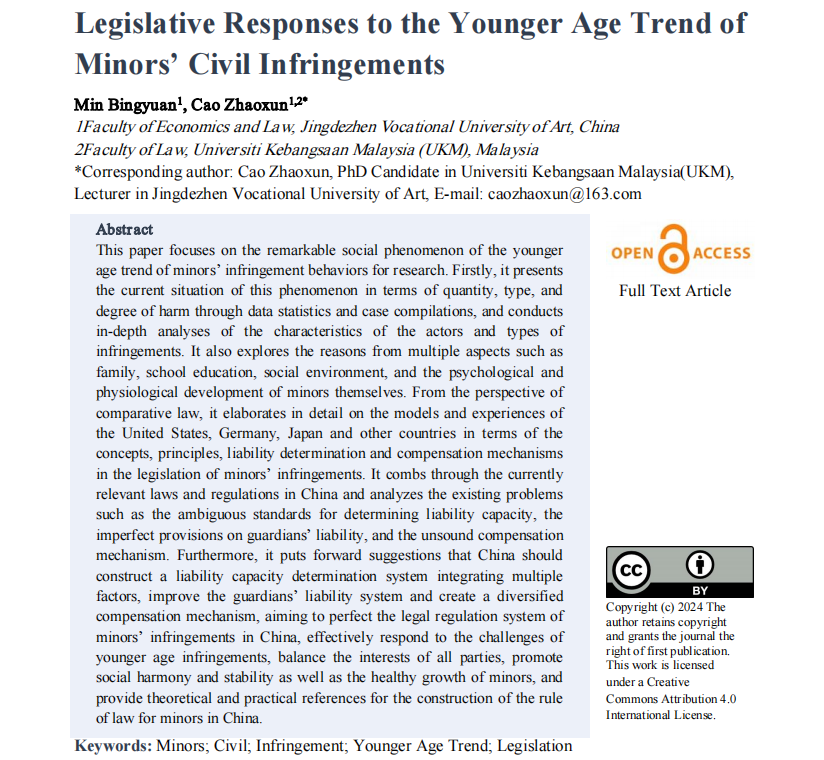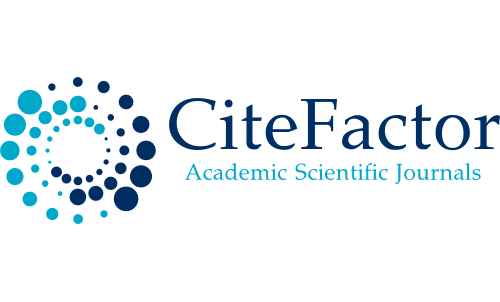Legislative Responses to the Younger Age Trend of Minors’ Civil Infringements
DOI:
https://doi.org/10.5281/zenodo.14553791Keywords:
Minors, Civil, Infringement, Younger Age Trend, LegislationAbstract
This paper focuses on the remarkable social phenomenon of the younger age trend of minors’ infringement behaviors for research. Firstly, it presents the current situation of this phenomenon in terms of quantity, type, and degree of harm through data statistics and case compilations, and conducts in-depth analyses of the characteristics of the actors and types of infringements. It also explores the reasons from multiple aspects such as family, school education, social environment, and the psychological and physiological development of minors themselves. From the perspective of comparative law, it elaborates in detail on the models and experiences of the United States, Germany, Japan and other countries in terms of the concepts, principles, liability determination and compensation mechanisms in the legislation of minors’ infringements. It combs through the currently relevant laws and regulations in China and analyzes the existing problems such as the ambiguous standards for determining liability capacity, the imperfect provisions on guardians’ liability, and the unsound compensation mechanism. Furthermore, it puts forward suggestions that China should construct a liability capacity determination system integrating multiple factors, improve the guardians’ liability system and create a diversified compensation mechanism, aiming to perfect the legal regulation system of minors’ infringements in China, effectively respond to the challenges of younger age infringements, balance the interests of all parties, promote social harmony and stability as well as the healthy growth of minors, and provide theoretical and practical references for the construction of the rule of law for minors in China.
Downloads
References
[1]Tejaswi, S., Chougule, P., & Salunkhe, S. (2020). Analysis of Crimes of Juveniles Delinquency Using Statistical Techniques. , 5, 89-92. https://doi.org/10.38124/ijisrt20jul064.
[2]Sbeglia, C., Randolph, I., Cavanagh, C., & Cauffman, E. (2023). Parental Legal Culpability in Youth Offending. Annual Review of Criminology. https://doi.org/10.1146/annurev-criminol-022422-121250.
[3]Clarke, A., Olive, P., Akooji, N., & Whittaker, K. (2020). Violence exposure and young people’s vulnerability, mental and physical health. International Journal of Public Health, 65, 357 - 366. https://doi.org/10.1007/s00038-020-01340-3.
[4]Nascimento, A., Andrade, J., & De Castro Rodrigues, A. (2022). The Psychological Impact of Restorative Justice Practices on Victims of Crimes—a Systematic Review. Trauma, Violence & Abuse, 24, 1929 - 1947. https://doi.org/10.1177/15248380221082085.
[5]Rodrigues, H., & Medina, J. (2022). EDUCATE FOR DEMOCRACY: THE IMPORTANCE OF LEGAL SOCIALIZATION. Cadernos de Pesquisa. https://doi.org/10.1590/198053149444_en.
[6]Tomasello, M. (2018). The Normative Turn in Early Moral Development. Human Development, 61, 248 - 263. https://doi.org/10.1159/000492802.
[7]Najafi, H. (2020). Vicarious Liability of Parents for Copyright Infringement by Minors: Review and Reform. Social Science Research Network. https://doi.org/10.2139/ssrn.3530754.
[8]Kim, Y., & Петрович, К. (2018). LEGAL REGULATION OF THE AGE OF CRIMINAL LIABILITY IN THE CONTEXT OF NOVELLING CRIMINAL LEGISLATION. Yugra State University Bulletin. https://doi.org/10.17816/BYUSU20180273-78.
[9]Takatori, Y., & Claxton, J. (2023). Mediation in Japan. Revista Brasileira de Alternative Dispute Resolution. https://doi.org/10.52028/rbadr.v5i9.art05.
[10]Wang, S. (2023). New development of Chinese Criminal law. COLLECTION OF SCIENTIFIC WORKS OF SOKHUMI UNIVERSITY. https://doi.org/10.52340/sou.2023.19.35.
[11]Azahra, A., Ulyana, Y., & Riyansyah, A. (2023). Legal Protection and Criminal Implications of Mistreatment of Minors: Analysis Based on Child Protection Law Number 35 of 2014. International Journal of Humanities, Law, and Politics. https://doi.org/10.46336/ijhlp.v1i3.35.
[12]Brzycki, M. (2023). Crime and Survival: Juvenile Offenders in the PRC. The Journal of the History of Childhood and Youth, 16, 248 - 265. https://doi.org/10.1353/hcy.2023.0026.
[13]Del Toro, J., Jackson, D., Testa, A., & Wang, M. (2023). The spillover effects of classmates' police intrusion on adolescents' school-based defiant behaviors: The mediating role of institutional trust.. The American psychologist. https://doi.org/10.1037/amp0001148.
[14]Roebers, C. (2022). Six- to eight-year-olds’ performance in the Heart and Flower task: Emerging proactive cognitive control. Frontiers in Psychology, 13. https://doi.org/10.3389/fpsyg.2022.923615.
[15]Paulich, K., Ross, J., Lessem, J., & Hewitt, J. (2021). Screen time and early adolescent mental health, academic, and social outcomes in 9- and 10- year old children: Utilizing the Adolescent Brain Cognitive Development ℠ (ABCD) Study. PLoS ONE, 16. https://doi.org/10.1371/journal.pone.0256591.
[16]Cuesta, I., Montesó-Curto, P., Sawin, E., Jiménez-Herrera, M., Puig-Llobet, M., Seabra, P., & Toussaint, L. (2021). Risk factors for teen suicide and bullying: An international integrative review.. International journal of nursing practice, e12930 . https://doi.org/10.1111/ijn.12930.
[17]Zadorozhna, A. (2022). SENSITIVITY IN THE ASPECT OF FORMATION OF VALUE ATTITUDE TO MORAL AND LEGAL NORMS IN CHILDREN. Academic Notes Series Pedagogical Science. https://doi.org/10.36550/2415-7988-2022-1-204-125-129.
[18]Teays, W. (2019). Crossing the Line: Online Violence. Library of Public Policy and Public Administration. https://doi.org/10.1007/978-3-030-05989-7_16.
[19]Molleman, L., Ciranka, S., & Van Den Bos, W. (2021). Social influence in adolescence as a double-edged sword. Proceedings of the Royal Society B: Biological Sciences, 289. https://doi.org/10.1098/rspb.2022.0045.
[20]Delgado, E., Serna, C., Martínez, I., & Cruise, E. (2022). Parental Attachment and Peer Relationships in Adolescence: A Systematic Review. International Journal of Environmental Research and Public Health, 19. https://doi.org/10.3390/ijerph19031064.

Downloads
Published
How to Cite
Issue
Section
License
Copyright (c) 2024 Zhaoxun Cao, Bingyuan Min

This work is licensed under a Creative Commons Attribution 4.0 International License.































